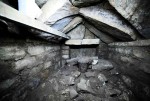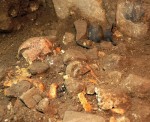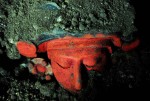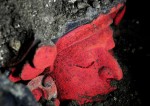 Archaeologists excavating the Zapotec vertical tomb complex discovered in the Oaxacan archeological site of Atzompa three months ago have discovered the remains of a high-ranking noble in the third chamber. In the previous two chambers researchers found thematically significant, well-preserved murals and small offerings including ceramic vessels and an engraved turtle shell, but no burials. Those chambers appear to have been emptied and filled with rubble in antiquity, possibly in a cancellation ritual when Atzompa was abandoned between 850 and 900 A.D. Although experts knew that the stacked chambers, the first such architecture ever discovered, were tombs, without human remains they couldn’t be certain the complex had ever been used for burials.
Archaeologists excavating the Zapotec vertical tomb complex discovered in the Oaxacan archeological site of Atzompa three months ago have discovered the remains of a high-ranking noble in the third chamber. In the previous two chambers researchers found thematically significant, well-preserved murals and small offerings including ceramic vessels and an engraved turtle shell, but no burials. Those chambers appear to have been emptied and filled with rubble in antiquity, possibly in a cancellation ritual when Atzompa was abandoned between 850 and 900 A.D. Although experts knew that the stacked chambers, the first such architecture ever discovered, were tombs, without human remains they couldn’t be certain the complex had ever been used for burials.
 The third chamber was the charm. It too was filled in antiquity with alternating layers of earth and stone, but it wasn’t cleared first. Instead the fill kept the skeletal remains and offerings safe from the ravages of looters and time. Archaeologists found the bones of a Zapotec noble, probably male. The skeleton wasn’t whole. Only the short, flat bones like vertebrae, ribs and sternum were discovered, plus large, important bones like the pelvis and skull. Along with the remains of this individual a second, fragmented skull was found, probably a sacrificial offering.
The third chamber was the charm. It too was filled in antiquity with alternating layers of earth and stone, but it wasn’t cleared first. Instead the fill kept the skeletal remains and offerings safe from the ravages of looters and time. Archaeologists found the bones of a Zapotec noble, probably male. The skeleton wasn’t whole. Only the short, flat bones like vertebrae, ribs and sternum were discovered, plus large, important bones like the pelvis and skull. Along with the remains of this individual a second, fragmented skull was found, probably a sacrificial offering.
Forensic anthropologists will analyze the skeletal remains to determine, if possible, the age at death, health, nutrition and whether there were any deliberate deformations of the bones for cultural purposes.
 Along with the human remains, the chamber contained a small black vessel and parts of a bowl. Under a stone slab archaeologists discovered an exceptional anthropomorphic clay urn shaped like a human face wearing earrings. A headdress was found detached on the other side of the chamber. The piece is 12 inches in diameter and 20 inches high without the headdress, about 28 inches with the headdress attached. The urn is painted a strikingly bright red, its rich hue perfectly preserved despite over 1100 years or so of existence by the fill in the chamber.
Along with the human remains, the chamber contained a small black vessel and parts of a bowl. Under a stone slab archaeologists discovered an exceptional anthropomorphic clay urn shaped like a human face wearing earrings. A headdress was found detached on the other side of the chamber. The piece is 12 inches in diameter and 20 inches high without the headdress, about 28 inches with the headdress attached. The urn is painted a strikingly bright red, its rich hue perfectly preserved despite over 1100 years or so of existence by the fill in the chamber.
 Researchers believe this third chamber was actually the first one built. Its location next to the House of the Altars made it prime real estate, so when they needed more prestige tombs, they carefully sealed the first one and built two more on top and added the stairway. They also reduced the size of the original tomb. It seems the third chamber was about 11.5 feet long originally, but some of that length was trimmed to make room for the staircase.
Researchers believe this third chamber was actually the first one built. Its location next to the House of the Altars made it prime real estate, so when they needed more prestige tombs, they carefully sealed the first one and built two more on top and added the stairway. They also reduced the size of the original tomb. It seems the third chamber was about 11.5 feet long originally, but some of that length was trimmed to make room for the staircase.
This would have happened in fairly quick succession. The date range for all three tombs is the same, 650 – 850 A.D. Archaeologists believe they were built within three generations.
Mexico’s National Anthropology and History Institute (INAH) has a nice photo gallery with some additional pictures of the find.